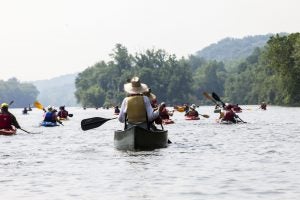Exploring urban islands: from natural to developed
Islands on Pennsylvania’s waterways are often overlooked, difficult to access or seen as liabilities, but some people are trying to change that.
ListenMichael Catania walks on a rocky beach at Petty’s Island. He picks up a flat stone and flings it out into the Delaware River. The stone skips a few times toward a shipping terminal and the church steeples of Philadelphia’s Port Richmond neighborhood.
“I feel like a little boy when I come here,” said Catania, chairman of the New Jersey Natural Lands Trust.
Wooden stakes protrude from the ground. The remains of an old pier line the perimeter of the beach. Plastic bottles, old tires, a TV, and bricks sliced in half — one side “key,” the other “stone,” litter the shoreline.
If everything goes as planned, in about five years, the rocky beach will become a part of a network of hiking trails that will traverse the island. Petty’s Island will be transformed from an industrial wasteland into a nature preserve — an urban oasis with forested areas on either end, grasslands, ponds and an education center.
“You get back in the trail in the woods and you forget where you are,” said Catania. “Five minutes later you burst into the open and see the Philadelphia skyline, and you realize how close you are to a really urban area. There’s not that many opportunities to be in the wild immediately adjacent to a major city.”

Petty’s Island, in-between Philadelphia and Camden, N.J., is about 500 acres, 200 of which are submerged wetlands.
Owned by CITGO, ponds surrounding rusted oil tanks have become habitats for birds and other wildlife on the island. Access is restricted. There is one bridge that connects to the mainland in Pennsauken, N.J. A security guard tracks cargo trucks going on and off the island.
Petty’s Island is one of hundreds of islands on the Delaware River — one of thousands on the waterways of Pennsylvania. Historically, islands close to cities have been used for industry, recreation and dumping grounds, said John Brady, president of the Independence Seaport Museum in Philadelphia. Some have been left untouched and others dug up and removed from rivers when they got in the way of commerce.
“I have been a sailor all of my life, and there is a certain romance that an island has,” said Brady. “To go explore an island is something I think appeals to all of us at a pretty deep level.”

Tracing the history of Petty’s Island, it’s hard to distinguish fact from legend. William Penn is said to have owned the island, and Blackbeard, the notorious pirate, is rumored to have docked there. In the later half of the 19th century, farmer Ralston Laird became known as the “king” of Petty’s Island.
At the turn of the 20th century, an oil refinery was built on the island and operated through World War II. Once the refinery shut down, the island was used as an oil storage facility. The hulking tanks, now empty and rusting, and fueling stations still remain there.
Today, CITGO’s operations are considered dormant, other than ongoing cleanup and environmental remediation ordered by the state of New Jersey. But the company leases part of the land to a shipping corporation that transports goods from Central America and the Caribbean.
When CITGO was winding down its operations on the island, it found an eagle’s nest and other wildlife that is considered threatened. The oil company decided to donate a conservation easement to the New Jersey Natural Lands Trust to take over the property once the island has been completely cleaned.
“It became apparent that what we had here was more than just a vacant industrial property,” said Jack McCrossin, manager of environmental, health, safety and security for CITGO. “You kind of get lost in the fact that you’re in one of the most urbanized areas of the east coast, when you see in the span of 10 minutes a bald eagle, white tail deer, red fox, wild turkey.”
But before the public will be able to get lost among the wildlife on Petty’s Island, the marine terminal must phase out its operations over the next two years. And then there’s the continued cleanup effort.
“Unfortunately what we are dealing with today is a lot of the past practices of those operations over the last 100 years,” said McCrossin. “The recognition of what was environmentally correct simply wasn’t in the lexicon of anyone during those early days. So, the majority of what we are dealing with now is soil and groundwater contamination that quite frankly is the result of past normal operating practice from the industry that was located here beginning in the early 1900s.”
McCrossin said CITGO has taken more than 1,000 soil and groundwater samples, has identified the areas of contamination and is working to remediate them. The company is still years away from completion and from being able to turnover the island to the Lands Trust.
In Pittsburgh, an island transformed
Like Petty’s Island, Washington’s Landing, once known as Herr’s Island, on the Allegheny River underwent extensive cleanup and remediation from industrial uses.
“It probably was one of the most contaminated pieces of dirt in the city of Pittsburgh,” said Robert Rubinstein, acting executive director of the Urban Redevelopment Authority of Pittsburgh.
Instead of oil, Herr’s Island was a stopover point to rest and slaughter cattle coming to the east coast from Chicago and the midwest. During clean up, URA found toxic pollutants like PCBs from an electrical power plant, battery acid from when the island was a scrap metal yard and animal renderings in the soil.
At his senior prom, Rubinstein said, he took a party cruise on the Allegheny River.
“I remember coming past this island, which was still a slaughtering house at the time, and just the putrid horrific smells, everybody came inside of the party ship because you couldn’t stand outside because the smell was just so horrific,” said Rubinstein.
Decades later, the smells and contamination of Washington’s Landing are hard to imagine. On the island, which is owned by the city of Pittsburgh, is mixed-use development with a full-scale marina, an office park, a rowing center, trails and recreational facilities. There’s also an upscale townhouse development once home to Pittsburgh Steeler’s quarterback Ben Roethlisberger.

“It was unfathomable that people would want to live on this island in the 1980s. It was completely unimaginable to anybody,” said Rubinstein.
To go from a place once considered foul to favorable, Rubinstein said the URA took a strategic approach, starting with changing perceptions of the island.
First they drew people to the island through rowing and recreation, then for jobs and lastly for housing.
Washington’s Landing is widely considered a success story; each year it brings in about $6 million in property taxes and 800 jobs. But Rubinstein said there is a limit to the success: the lack of spillover affect it is has on the mainland.
“When you’re dealing with an island, you’re an island. You’re literally an island. So it’s hard to have that off-site catalytic impact, where in today’s climate, we want to get more bang for our buck when we’re investing a public dollar,” said Rubinstein.
Harrisburg’s “playground”
If the plan for Petty’s Island is to become a nature preserve, and Washington’s Landing is upscale development, than City Island in Harrisburg is somewhere in-between.
City Island is less than a mile long and sits on the Susquehanna River, a short walk across the Walnut Street Bridge from downtown Harrisburg. The island is one of 27 parks owned and managed by the city. Because it’s in the floodplain, the island is limited to recreational use only.
The island is a good place for locals to walk their dogs or go for a jog, and it’s also a destination for tourists. You can catch a game at Metro Bank Park, home the city’s minor league baseball team, the Senators, or play a round of mini golf. But there’s a shuttered bath house by the concrete beach and the City Islanders, Harrisburg’s professional soccer team, say they need a new stadium.

A study by the Urban Land Institute in 2014 found that, “large swaths of the island are underutilized or undeveloped.” The ULI made a series of recommendations for improvements, starting with the development of a master site plan and including more year-round activities.

To Steve Oliphant, City Island is Harrisburg’s playground. Oliphant has been running Susquehanna Outfitters, a small business that rents kayaks, canoes and bicycles, for 10 years.
He’s skeptical that the city can make the island more vibrant.
“The city is broke,” said Oliphant. “What do you do with no money, with no budget and with a city that has an extraordinary amount of nontaxable land and a population that quite a bit of it is below poverty level?”

The City Islander’s soccer team has played there for 12 years.
“We are kind of the Davids in the David versus Goliaths of our league,” said Eric Pettis, one of the team owners. “If you look at some of the new teams that are coming into the league, they’re much bigger. Bigger budgets, markets, everything.”
Despite their underdog status, the Islanders still bring in a sold-out crowd of more than 2,500 people to home games at Skyline Sports Complex. But with the league expanding, the stadium does not meet minimum standards.
“Our surface is great. It’s really good grass, so that’s not an issue,” said Pettis. “It’s a great place to watch a game. But as far as amenities — it lacks.”
In May, the team applied for a $5 million grant in state funds through the Redevelopment Assistance Capital Program to build a new multi-use stadium.
The improvements would double capacity to 5,000 spectators and add restrooms, running water, an entrance plaza, locker rooms, a VIP area, a broadcast booth and other improvements. The total cost of the project would be $8–14 million.
Pettis said if the team is not awarded the state funds, it will have to go somewhere else.
Jackie Parker, Harrisburg’s director of community and economic development said the city supports the Islanders in building a new stadium and she sees it as an opportunity to host other events including concerts.
She said the the island should be thought of as more of a “Main Street” with a dedicated manager and better use of the land.
“You’re trying to think of — are there ways to raise money to sustain the island, to maintain the island,” said Parker “It’s a limited space, we have limited resources as a city. You want business to be here, but not to over build so that people can still enjoy it.”
Whether City Island becomes more of a Main Street or Harrisburg’s playground, the challenge is finding the right balance between having businesses on the island and keeping it as natural as possible, Parker said.
Development verses preservation
On Petty’s Island, at one point a developer had proposed luxury housing, a golf course and a marina, said Michael Catania. But the economy tanked, and the proposal washed away. CITGO granted the conservation easement to the Trust in 2009, which prohibited most development and active recreation.
“It’s going to be a long process to do the clean up, phase out the marina operations and do the restorations to the island, but ultimately I think it’s something that’s well worth it,” said Catania. “I think anyone who has had any role in this is going to look back on this someday when there are families out here enjoying the wildlife, thinking this is a great thing that we have done preserving Petty’s Island.”
Until then, the Trust sponsors 12 programs a year to visit Petty’s Island.
WHYY is your source for fact-based, in-depth journalism and information. As a nonprofit organization, we rely on financial support from readers like you. Please give today.







